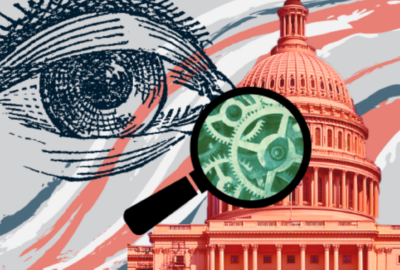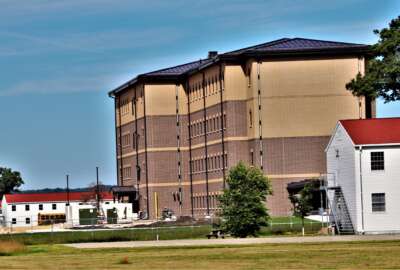Out of nearly 500 entries, the Partnership for Public Service has selected 30 finalists for the 2015 Samuel J. Heyman Service to America Medals.
The “Sammies” is one of the most prestigious awards honoring civil servants. This year’s achievements include pioneering new treatments for cancer and sickle cell disease, improving fire safety for commercial airliners, developing a geographically targeted cell phone alert system to warn of dangers from tornadoes and flash floods, finding alternatives to the use of antibiotics in poultry and coordinating the U.S. response to the Ebola crisis in West Africa.
“The Service to America Medal finalists showcase the good that our public servants do each and every day behind-the-scenes on behalf of the American public,” said Max Stier, Partnership for Public Service President and CEO. “They epitomize the true spirit and value of public service.”
Eight medal recipients will be chosen by a committee that includes familiar faces like former U.S. Department of Transportation Secretary Ray LaHood and National Treasury Employees Union Nation President Colleen M. Kelley. The winners, including Federal Employee of the Year, will be announced Oct. 7 a gala in Washington, D.C.
“Our government is the only tool we have as a country to deal with some of our most pressing problems and it’s all about the people in government,” Stier said in an interview with the Federal Drive with Tom Temin We believe that if we want the government that’s going to serve us best, we need to make sure that we recognize the many, many wonderful things that our federal workers are doing.”
The 2015 finalists will be honored May 6 on Capitol Hill in Washington, D.C., as part of Public Service Recognition Week.
“Federal employees don’t believe that they get they get recognition for their good work, and that’s a real problem. And when I say that, it’s true compared to an equivalent group of private sector employees,” Steir said. “And everyone wants to be recognized. Federal employees are doing what they do because they care about their mission. They’re not there because they want to maximize the money they’re bringing home. And part of what leaders in those organizations can do is recognize them for what they’re doing.”
Hear the finalists stories in their own words as Federal News Radio brings you a new Sammies interview each week on the Federal Drive with Tom Temin and In Depth with Francis Rose.
| Career Achievement Medal Finalists |
- Robert J. Kavlock, Deputy Assistant Administrator for Science, Office of Research and Development, Environmental Protection Agency, Washington, D.C.
Transformed how the EPA tests the toxicity of industrial and household chemicals, dramatically increasing the number that are assessed for potential health risks, while reducing the cost, time and need for animal studies.
- Hyun Soon Lillehoj, Senior Research Molecular Biologist, Agricultural Research Service, Beltsville, Maryland
Led influential research to decrease the use of antibiotics in commercial poultry, ensure the safety of this popular food and make the U.S. poultry industry more competitive overseas.
- Charles E. Milam, Principal Director, Military Community and Family Policy, Department of Defense, Washington, D.C.
Improved the lives of millions of service members and their families by instituting programs that help deployed soldiers stay in touch with loved ones, and increase health and wellness on military bases
- Dr. Steven A. Rosenberg, Chief, Surgery Branch, National Institutes of Health, National Cancer Institute, Bethesda, Maryland
Developed life-saving treatments for millions of cancer patients, pioneering the use of the body’s immune system and genetically engineered anti-tumor cells to fight the disease.
|
| Call to Service Medal Finalists |
- Gretchen K. Campbell, Physicist, National Institute of Standards and Technology, Gaithersburg, Maryland
Advanced the emerging field of physics known as atomtronics, paving the way for a new generation of technologies much like electronics has transformed our society today
- Stephanie L. Hogan, Attorney-Advisor, Acting Team Leader for Interstate Transport of Air Pollution, Environmental Protection Agency, Washington, D.C.
Protected citizens from dangerous power plant emissions that blow across state lines by leading the EPA’s legal defense of its interstate air pollution rule.
- Bridget Lynn Roddy, Virtual Student Foreign Service Program Manager, Department of State, Washington, D.C.
Engaged a growing number of college students who contribute new skills, ideas and energy to assist diplomatic and international development programs around the world while working remotely from any location.
- Adam R. Schildge, Senior Program Analyst, Federal Transit Administration, Washington, D.C.
Developed and implemented a multi-billion dollar grant program after Hurricane Sandy to make public transportation systems more resilient against future natural disasters.
|
| Citizen Services Medal Finalists |
- Lucile Jones, Science Advisor for Risk Reduction, U.S. Geological Survey, Pasadena, California
Spurred communities and states to prepare for catastrophic earthquakes by applying her groundbreaking research and taking preventive measures to protect citizens and critical infrastructure.
- Constantine P. Sarkos, Manager, Fire Safety Branch, Federal Aviation Administration, Egg Harbor Township, New Jersey
Protected commercial air travelers by leading major fire safety improvements that have increased passenger survivability during blazes occurring in-flight and after crash landings.
- Kevin G. Stricklin and the MSHA Mine Emergency Team, Administrator for Coal Mine Safety and Health, Department of Labor, Mine Safety and Health Administration, Arlington, Virginia
Improved coal mine safety and reduced deadly accidents to the lowest number in history, and led dangerous rescue operations to save trapped miners.
- John P. Wagner, Deputy Assistant Commissioner, Office of Field Operations, U.S. Customs and Border Protection, Washington, D.C.
Reduced wait times for American citizens and a growing number of foreign travelers arriving at U.S. airports by expediting the clearance process while ensuring a high level of security.
|
| Homeland Security and Law Enforcement Medal Finalists |
- Robert Bunge, Michael Gerber and the Wireless Emergency Alerts Team, Software Branch Chief, Telecommunications Operations Center (Bunge), Meteorologist (Gerber), National Oceanic and Atmospheric Administration, National Weather Service, Silver Spring, Maryland
Saved countless lives by developing a fast and geographically targeted cell phone alert system for weather emergencies such as tornadoes and flash floods.
- Anna M. Dozier, Senior Investigator, Employee Benefits Security Administration, Kansas City, Missouri
Protected and recovered millions of dollars in assets for American workers and their families by skillfully investigating misconduct by fiduciaries of private retirement, health and welfare plans.
- John B. Price, Program Manager, Department of Homeland Security, Science and Technology Directorate, Washington, D.C.
Created a device to find living disaster victims buried beneath the wreckage of toppled buildings by adapting radar-based space technology in partnership with NASA scientists.
- Ron Ross, Fellow, National Institute of Standards and Technology, Gaithersburg, Maryland
Instituted a state-of-the-art risk assessment system that has protected federal computer networks from cyberattacks and helped secure information critical to our national and economic security.
|
| Management Excellence Medal Finalists |
- Kevin L. Hannes and the FEMA Operation Precious Cargo Team, Federal Coordinating Officer, Federal Emergency Management Agency, Denton, Texas
Coordinated emergency assistance when tens of thousands of unaccompanied minors from Central America crossed the Southwest border, providing them food, shelter and medical care, and helping unite the children with family members.
- Edward C. Hugler, Deputy Assistant Secretary for Operations, Department of Labor, Washington, D.C.
As the Labor Department’s “Mr. Fix It,” solved numerous critical management challenges, including saving the agency’s financial management system after its service provider went bankrupt.
- Susan S. Kelly and the DOD Transition to Veterans Program Office, Director, Transition to Veterans Program Office, Department of Defense, Rosslyn, Virginia
Transformed and enhanced how the federal government annually prepares more than 200,000 service members for their transition to civilian life.
- Edward J. Ramotowski and the Consular Affairs Team, Deputy Assistant Secretary for Visa Services, Department of State, Bureau of Consular Affairs, Washington, D.C.
Increased the number of foreign visitors to the U.S., boosted economic activity and created jobs by improving visa processing capacity and reducing interview wait times at embassies worldwide.
- Steven W. Zander, Director, AF Community Partnership Program, Department of the Air Force, Washington, D.C.
Developed innovative partnerships between Air Force bases and neighboring cities to save money on essential community services, from recreation activities to snow removal.
|
| National Security and International Affairs Medal Finalists |
- Mia Beers and the U.S. Ebola Disaster Assistance Response Team, Division Director, Humanitarian Policy and Global Engagement Division, U.S. Agency for International Development, Washington, D.C.
Led a team of U.S. responders who risked their own health to coordinate personnel from five federal agencies and helped turn the tide on the 2014 Ebola crisis in West Africa.
- Natasha M. de Marcken, Director, Office of Education, U.S. Agency for International Development, Washington, D.C.
Spearheaded a new strategy to improve the quality of education in developing nations, shifting the focus from simply getting children into schools to teaching them to read.
- Timothy A. Blades, Paul S. Gilmour and Team, Director of Operations, Directorate of Program Integration (Blades); Deputy Director, Office of Ship Operations (Gilmour); Edgewood Chemical Biological Center (Blades); U.S. Maritime Administration (Gilmour); Aberdeen, Maryland (Blades); Washington, D.C. (Gilmour)
Led an interagency team to destroy Syria’s lethal chemical weapons at sea, a first in the history of chemical demilitarization.
- Peter A. Morrison and the U.S. Navy Solid State Laser Team, Program Officer, Office of Naval Research , Department of the Navy, Arlington, Virginia
Provided the U.S. Navy with a new defense system by designing, building and testing the first-ever laser weapon to be approved for combat operations aboard a Navy ship.
- Rob Thayer and the Syria Emergency Food Assistance Team, Team Leader, Asia and Near East, U.S. Agency for International Development, Office of Food for Peace, Washington, D.C.
Delivered life-saving food assistance to millions of people within war-torn Syria and to refugees who fled to neighboring countries.
|
| Science and Environment Medal Finalists |
- Richard Alan Feely, NOAA Senior Fellow, National Oceanic and Atmospheric Administration, Seattle, Washington
Conducted eye-opening research on ocean acidification caused by global carbon dioxide emissions, which poses a serious risk to the health of sea life and the marine environment, and to people who rely on the oceans for food.
- Jacob E. Moss, Senior Adviser, Environmental Protection Agency, Washington, D.C.
Built an alliance of federal and international agencies, countries and corporations to bring more efficient cook stoves and cleaner burning fuels to homes in developing nations, protecting the environment and the health of millions of people worldwide.
- Dr. Griffin P. Rodgers, Director, National Institute of Diabetes and Digestive and Kidney Diseases, National Institutes of Health, Bethesda, Maryland
Developed the first effective drug treatment for sickle cell disease to lessen pain and suffering, and oversaw a stem cell transplant clinical trial that reversed the debilitating illness in a majority of patients and could soon lead to a cure for this devastating illness.
- Jean C. Zenklusen, Carolyn Hutter and The Cancer Genome Atlas Team, Director, The Cancer Genome Atlas Program Office, National Cancer Institute (Zenklusen); Team Leader, National Human Genome Research Institute (Hutter), National Institutes of Health, Bethesda, Maryland
Mapped thousands of gene sequences for more than thirty types of cancer, advancing precision medicine in the diagnosis, treatment and prevention of these deadly diseases.
|
RELATED STORIES:
2014 Service to America Medal finalists announced
Copyright
© 2024 Federal News Network. All rights reserved. This website is not intended for users located within the European Economic Area.





